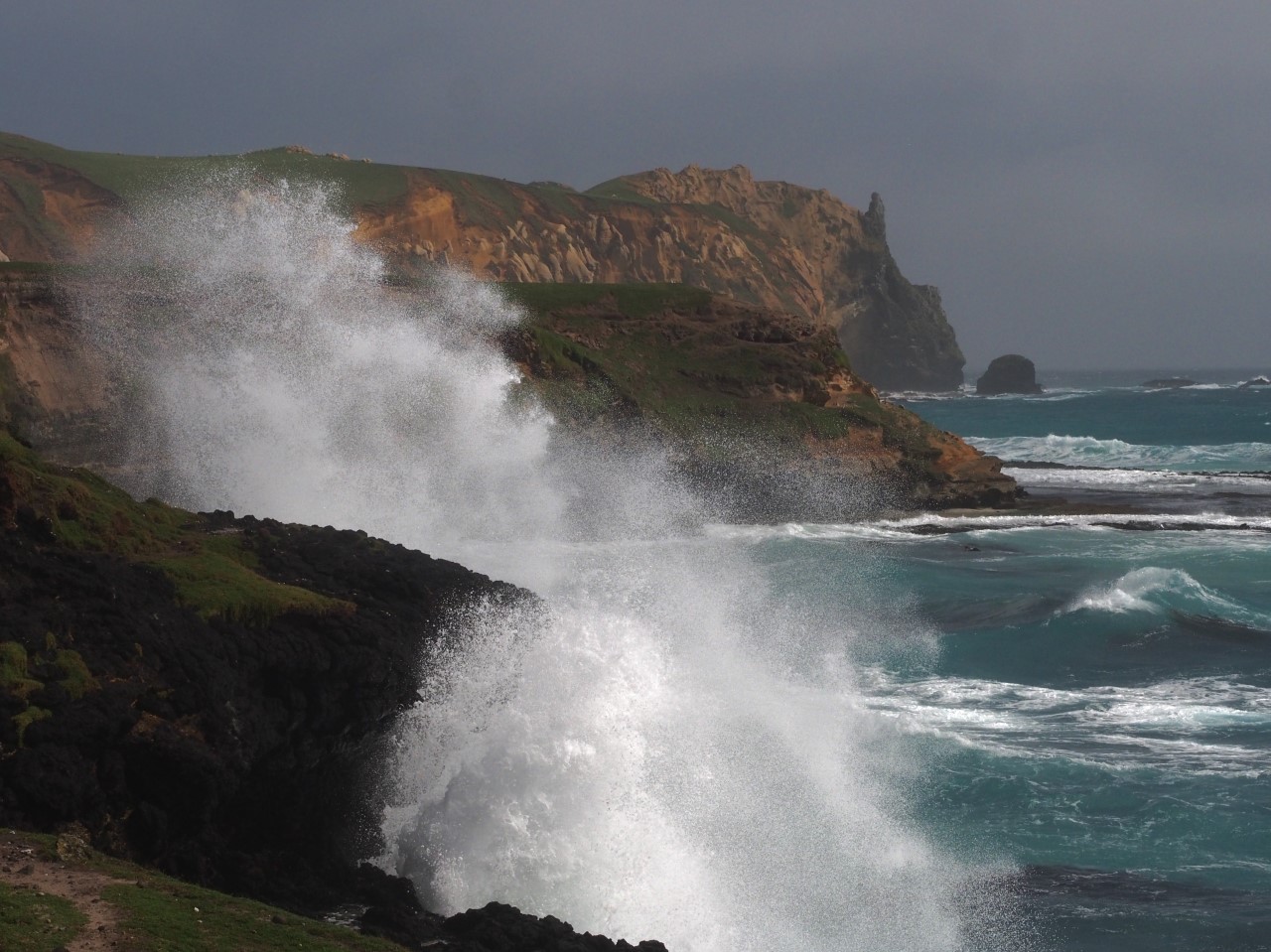Respiratory physician Lutz Beckert considers chronic obstructive pulmonary disease management, including the prevention of COPD, the importance of smoking cessation and pulmonary rehabilitation, and the lifesaving potential of addressing treatable traits. He also discusses the logic of inhaler therapy, moving from single therapy to dual and triple therapy when indicated, as well as other aspects of management
From central France to remote NZ
From central France to remote NZ

Photographer and specialist GP Martin London took his camera to the wild coast of Chatham Island and marvelled at the rocky vistas
Before we set off, I must take you back almost exactly 50 years.
A group from Magdalen College School, Oxford, UK were on a trip to the French Pyrenees, travelling by trains, planes and automobiles and arriving in dribs and drabs at Cauterets.
Apart from us schoolboys, the group consisted of two music masters and their wives, the school’s boarding-house matron, a physics master with a commendable appreciation of the wit of Michael Flanders and Donald Swann (At the Drop of a Hat), and classics teacher Mike.
My climbing partner David and I were travelling with Mike in his clapped-out Cortina, bringing much of the climbing gear. Mike was terrifying. Not in the way school masters can be terrifying. Mike was terrifying because of his driving. He was scarily incompetent on British roads and, on other side of the road in France, he became truly terrifying. So, at the first opportunity, I suggested he take a rest. From then on, David and I took turns driving all the way through central France to the mountains.
En route (note that little French touch), we stopped at Chartres. Chartres boasts a gobsmacking cathedral. It’s the one with the asymmetric spires flanking a rose window over the western door.
As we entered the vast old cathedral, a man with a group of visitors around him called out, “Please join us. There is no charge. Today we are looking at this window.” For 45 minutes, he talked in delightful detail about a single stained-glass window and its history, artistic attributes and symbolism. He said he had been presenting in this way for 14 years, choosing a different small part of the cathedral on which to focus each day’s tour. It was enthralling and captivating, in delightful contrast to the 15-franc whizz around of a site’s notable features that many tour guides offer when they have obviously learned only the standard patter.
Cape Young, at the northern-most point of Chatham Island, puts me in mind of this cathedral. The area is geologically rich in tale and image, and feels like a huge sculpture park.
Most of the rock on the Chathams is volcanic, with the added charm that the volcanic cones were formed under water and then emerged with continental uplift. Apparently, this accounts for their distinctive symmetry.
Under water, fine particulate lava flows also formed volcanic sediments which, under pressure, became the granular breccias (fragments). According to Hamish Campbell, the guru of Chatham Island geology, these sediments are known as tuff. In the case of Cape Young, red and ochre deposits named Momoe-a-toa Tuff have formed, perhaps with their underwater birth or maybe through wind erosion, some rather wonderful sculpted shapes. Through this overlay, dark volcanic basalts emerge.
I wonder what mythology the Moriori attached to these marvellous formations, cliffs and gullies.
Not knowing the answers, it’s easy to succumb to anthropomorphisation or just to delight in the wide spaces, the crashing waves and the head-spinning breeze.
And then we come to the sole work left by the British artist Henry Moore, renowned for his large-scale outdoor sculptures, when he left the hurly-burly of the London art scene to do an artist-in-residence stint on the Chatham Islands. Moore said he was pushing the boundaries of art to the boundaries of the Western world. He found it quite a struggle here amongst a fairly hostile population and ended up producing just one work, “Shitting Bricks”. A bit like driving with Mike!
I’ll end our tour with this “portrait of the artist as a young dromedary”.
- Log in to post comments










![Barbara Fountain, editor of New Zealand Doctor Rata Aotearoa, and Paul Hutchison, GP and senior medical clinician at Tāmaki Health [Image: Simon Maude]](/sites/default/files/styles/thumbnail_cropped_100/public/2025-03/Barbara%20Fountain%2C%20editor%20of%20New%20Zealand%20Doctor%20Rata%20Aotearoa%2C%20and%20Paul%20Hutchison%2C%20GP%20and%20senior%20medical%20clinician%20at%20T%C4%81maki%20Health%20CR%20Simon%20Maude.jpg?itok=-HbQ1EYA)
![Lori Peters, NP and advanced health improvement practitioner at Mahitahi Hauora, and Jasper Nacilla, NP at The Terrace Medical Centre in Wellington [Image: Simon Maude]](/sites/default/files/styles/thumbnail_cropped_100/public/2025-03/2.%20Lori%20Peters%2C%20NP%20and%20advanced%20HIP%20at%20Mahitahi%20Hauora%2C%20and%20Jasper%20Nacilla%2C%20NP%20at%20The%20Terrace%20Medical%20Centre%20in%20Wellington%20CR%20Simon%20Maude.jpg?itok=sUfbsSF1)
![Ministry of Social Development health and disability coordinator Liz Williams, regional health advisors Mary Mojel and Larah Takarangi, and health and disability coordinators Rebecca Staunton and Myint Than Htut [Image: Simon Maude]](/sites/default/files/styles/thumbnail_cropped_100/public/2025-03/3.%20Ministry%20of%20Social%20Development%27s%20Liz%20Williams%2C%20Mary%20Mojel%2C%20Larah%20Takarangi%2C%20Rebecca%20Staunton%20and%20Myint%20Than%20Htut%20CR%20Simon%20Maude.jpg?itok=9ceOujzC)
![Locum GP Helen Fisher, with Te Kuiti Medical Centre NP Bridget Woodney [Image: Simon Maude]](/sites/default/files/styles/thumbnail_cropped_100/public/2025-03/4.%20Locum%20GP%20Helen%20Fisher%2C%20with%20Te%20Kuiti%20Medical%20Centre%20NP%20Bridget%20Woodney%20CR%20Simon%20Maude.jpg?itok=TJeODetm)
![Ruby Faulkner, GPEP2, with David Small, GPEP3 from The Doctors Greenmeadows in Napier [Image: Simon Maude]](/sites/default/files/styles/thumbnail_cropped_100/public/2025-03/5.%20Ruby%20Faulkner%2C%20GPEP2%2C%20with%20David%20Small%2C%20GPEP3%20from%20The%20Doctors%20Greenmeadows%20in%20Napier%20CR%20Simon%20Maude.jpg?itok=B0u4wsIs)
![Rochelle Langton and Libby Thomas, marketing advisors at the Medical Protection Society [Image: Simon Maude]](/sites/default/files/styles/thumbnail_cropped_100/public/2025-03/6.%20Rochelle%20Langton%20and%20Libby%20Thomas%2C%20marketing%20advisors%20at%20the%20Medical%20Protection%20Society%20CR%20Simon%20Maude.jpg?itok=r52_Cf74)
![Specialist GP Lucy Gibberd, medical advisor at MPS, and Zara Bolam, urgent-care specialist at The Nest Health Centre in Inglewood [Image: Simon Maude]](/sites/default/files/styles/thumbnail_cropped_100/public/2025-03/7.%20Specialist%20GP%20Lucy%20Gibberd%2C%20medical%20advisor%20at%20MPS%2C%20and%20Zara%20Bolam%2C%20urgent-care%20specialist%20at%20The%20Nest%20Health%20Centre%20in%20Inglewood%20CR%20Simon%20Maude.jpg?itok=z8eVoBU3)
![Olivia Blackmore and Trudee Sharp, NPs at Gore Health Centre, and Gaylene Hastie, NP at Queenstown Medical Centre [Image: Simon Maude]](/sites/default/files/styles/thumbnail_cropped_100/public/2025-03/8.%20Olivia%20Blackmore%20and%20Trudee%20Sharp%2C%20NPs%20at%20Gore%20Health%20Centre%2C%20and%20Gaylene%20Hastie%2C%20NP%20at%20Queenstown%20Medical%20Centre%20CR%20Simon%20Maude.jpg?itok=Z6u9d0XH)
![Mary Toloa, specialist GP at Porirua and Union Community Health Service in Wellington, Mara Coler, clinical pharmacist at Tū Ora Compass Health, and Bhavna Mistry, specialist GP at Porirua and Union Community Health Service [Image: Simon Maude]](/sites/default/files/styles/thumbnail_cropped_100/public/2025-03/9.%20Mary%20Toloa%2C%20Porirua%20and%20Union%20Community%20Health%20Service%20in%20Wellington%2C%20Mara%20Coler%2C%20T%C5%AB%20Ora%20Compass%20Health%2C%20and%20Bhavna%20Mistry%2C%20PUCHS%20CR%20Simon%20Maude.jpg?itok=kpChr0cc)